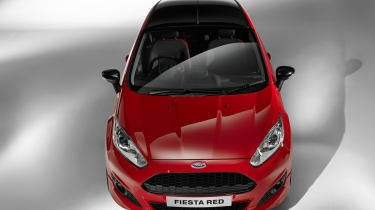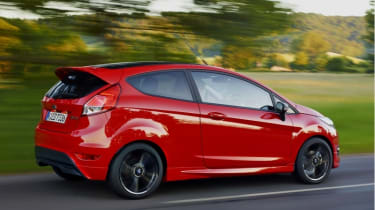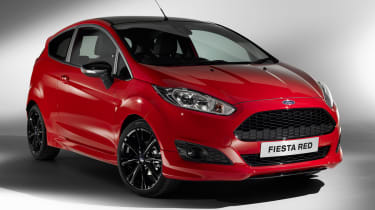Ford Fiesta Zetec S Red Edition review - the insurance friendly ST?
All the fun of a warm hatch with the running costs of a supermini
What is it?
At first glance, Ford’s new Fiesta Zetec S Red Edition might appear a little overpriced. With a dinky 1-litre EcoBoost engine, it produces a healthy 138bhp. The problem is that 138bhp is some 41bhp less than what the more focused Fiesta ST develops – a car that costs only an additional £1200. That leaves us asking a question: why would you ever opt for the less potent car? A quick skim down the spec sheet, however, reveals the answer: running costs.
With the engine under the Red Edition’s bonnet being one cylinder and 597cc down on the ST’s in-line turbocharged four, Ford claims it can eke out an impressive 62.8mpg combined. This comfortably trumps the ST’s 47.9mpg, and then there’s the issue of insurance. Thanks to the ST’s Group 30 ranking, it’s out of reach for many younger or drivers. The Group 15 Red Edition is far more accessible.
Then there’s road tax. The more eco-friendly Red Edition costs £20 a year to tax while the ST costs £110 more. It’s a similar story with servicing costs. It almost sounds too good to be true – surely these savings result in a significantly less engaging drive?
Engine, transmission and 0-60 time
Before we take to the road, let’s look at one of the car’s defining features. The Red Edition’s turbocharged 1-litre EcoBoost engine is the same unit found in the most potent version of the regular Fiesta Zetec S. Its peak output is rated at 138bhp (that’s 13bhp/litre more than a Ferrari 458) at 6000rpm, while torque reaches 155lb ft at 1400rpm during overboost bursts (it otherwise peaks at 133lb ft).
More reviews
Like the 138bhp Zetec S, the Red Edition sends drive to the front wheels via a five-speed manual gearbox. It also shares the standard car’s shortened gear ratios, and so reaches 62mph in nine seconds dead. Despite these truncated ratios, top speed is a quoted 125mph.
Technical Highlights
With a heated front windscreen, heated mirrors, hill-start assist and air con on the list of standard features, the Red Edition features enough creature comforts to be a comfortable daily driver. The car’s sporty bodywork and 17-inch eight-spoke wheels are also standard. As the names suggest, just two colours are available – red or black (for the sibling Black Edition model).
The Fiesta doesn’t get Ford’s SYNC 2 infotainment and makes do with the first-generation system instead. The £500 option does, however, add satnav with traffic updates and speed camera alerts as well as DAB radio, so is a worthwhile addition for anyone racking up big mileage.
The car’s standard-fit sports seats provide good support and bolstering, and look the part too. Compared to newer cars, the Fiesta’s dash is rather cluttered with buttons, but the overall design is attractive and reasonably easy to use.
What’s it like to drive?
Brilliant fun. Much like one of its key rivals, the Suzuki Swift Sport, there’s a sense of the old school to the car’s character. Unlike the Swift, however, the Fiesta mixes this with mid-range grunt. While there’s a joy to having to work an engine hard, the Fiesta’s torque is far more accessible, leaving you with more options to maintain pace.
The engine produces its peak power at 6000rpm, so there’s reason to rev it out, but you can still accelerate out of tighter bends in a gear higher than you might expect, riding a wave of overboost torque that arrives from 1400rpm.
With this, the engine emits an addictive three-pot growl with a hint of turbo whine under load. It’s just a shame that the Red Edition seems to have inherited the regular Zetec S’s bonnet insulation, ensuring the volume remains fairly low.
Given the talents of that engine, to judge the chassis to be the star of the show really emphasises just how good it is. In many ways it feels identical to the ST’s – the front is darty while the rear is more than happy to cock a wheel, helping to adjust your line of attack with the throttle. The damping is also excellent, soaking up uneven surfaces while keeping the body calm and composed.
The car feels light on its toes, too, and while there’s little doubt that the ST is overall the more agile car (especially at higher speeds), on a twisty, technical B-road, a well-driven Red Edition would be hard to shake off.
Though the steering offers little in the way of genuine feel, such is its speed of response that you’ll find yourself driving with tiny, swift swipes of the wheel. Admittedly, over broken sections of tarmac there’s a little steering-column vibration that can initially feel quite disconcerting, but it never goes so far as to affect the car’s trajectory.
Ignore the occasional shake and you can really attack a road. It goes something like this: enter a corner off the throttle, take one swipe of the wheel to angle the car at the apex, feel the rear widen your approach line and pin the accelerator back into the carpet – it’s all very ST-like. Unsurprisingly, the more powerful ST is significantly more throttle adjustable – the 1-litre EcoBoost can bog down if the slip angle is too great – but learn how to keep the Red Edition within its narrower window of play and it’s an equally rewarding experience.
It’s also pleasingly easy to do, as the gearbox can handle fast changes and the engine is responsive enough to justify heel-and-toeing. Every part of the car rewards being hustled. Even the brakes – which feature drums at the rear – can take a pounding. It’s amazing to say this about something with a three-cylinder, 1-litre engine, but the Red Edition is a real drivers’ car.
Rivals
The Suzuki Swift Sport is another evo favourite from the warm hatch sector and runs the Fiesta close for chassis dynamics, albeit in a more softly sprung package. The Swift’s naturally aspirated 1.6-litre engine appears somewhat dated next to the Red Edition’s EcoBoost unit – it produces 134bhp at 6900rpm and 118lb ft of torque at 4400rpm and can only manage a claimed 44.1mpg – but its revvy character makes working it hard even more rewarding. Nevertheless, the Fiesta does just manage to top the Suzuki as an overall package; though it should do, given that the Swift starts at £13,999.
Then there’s the Vauxhall Adam S (previously the Grand Slam). With 148bhp and 162lb ft of torque available at 4900-5500rpm and 2750-4500rpm respectively, its turbocharged 1.4-litre engine is slightly more potent than the Fiesta’s three-cylinder unit. It’s therefore half a second faster to 62mph and can reach 130mph, but the car’s setup offers an altogether less dynamic experience. It’s priced similarly to the Fiesta, starting at £16,995.
The Mini Cooper is probably the most complete rival to the Fiesta. We suspect many buyers will prefer the overall look of the Ford, but the Mini’s agile yet planted chassis is in many ways on par with the Fiesta’s. The Mini makes use of a 1.5-litre three-cylinder engine with similar performance to the Fiesta – 134bhp and 162lb ft of torque mixes with a claimed 62.8mpg – but we'd argue that the Red Edition’s setup is more playful on the limit. The Cooper is cheaper, however, starting at £15,845.
Price
The Fiesta Red Edition (and Black Edition) starts at £16,345. Tick a few option boxes and this figures quickly grows, however, as is the case with our £18,120 test car. That’s a lot of money for a warm hatch, especially when you consider that the ST starts at £18,545. In fact, it’s the only trait that stopped us from giving the Red Edition a 4.5 star rating.
But, leave off options such as the £500 SYNC infotainment system, £275 climate control, £200 parking sensors and £200 privacy glass, and take advantage of any discounts on offer (Ford dealers have been known to knock hefty chunks off list prices) and you’ll still have yourself a great handling warm hatch that’s cheap to run. Even with savings, against rivals such as the comparatively cheap and well-specced Suzuki Swift Sport and the more chic Mini Cooper, the Fiesta appears expensive. But those who place driving fun above all else will likely find it easy to justify the premium.







